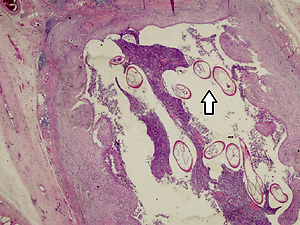Online first
Current issue
Archive
Special Issues
About the Journal
Publication Ethics
Anti-Plagiarism system
Instructions for Authors
Instructions for Reviewers
Editorial Board
Editorial Office
Contact
Reviewers
All Reviewers
2025
2024
2023
2022
2021
2020
2019
2018
2017
2016
General Data Protection Regulation (RODO)
CASE REPORT
A rare clinical presentation of human Dirofilaria repens infection as a pseudo-tumour of the epididymis – Case Report
1
P.J.Šafárik University, Medical Faculty and L.Pasteur University Hospital, Košice, Slovak Republik, Slovak Republic
2
Pallas Klinik, Switzerland
Corresponding author
Vincent Nagy
P.J.Šafárik University, Medical Faculty and L.Pasteur University Hospital, Košice, Slovak Republik, Tried SNP 1, 040 11, Košice, Slovak Republic
P.J.Šafárik University, Medical Faculty and L.Pasteur University Hospital, Košice, Slovak Republik, Tried SNP 1, 040 11, Košice, Slovak Republic
Ann Agric Environ Med. 2021;28(2):348-351
KEYWORDS
TOPICS
ABSTRACT
Introduction. Epididymal dirofilariasis is one of the unusual manifestations of this zoonosis. In Slovakia, this is the third case out of 20 Dirofilaria repens infected patients in whom the worm (the parasite) was identified in the epididymis. The patient felt a painless tumour about 2 cm in size on the left testicle. During ultrasound examination, the radiologist observed a cyst containing a live worm within the epididymis. After mechanical stimulation, the movement characteristic for filarial worms (´filarial dance sign´) appeared. An orchiectomy was performed at the Department of Urology in the University Hospital in Košice. Histopathology confirmed a parasitic cyst with a worm, and based on characteristic morphological features, the parasite was identified as Dirofilaria repens.
Objective. The aim of case report is to alert physicians to the possibility dirofilarial infection of the epididymis, where tumors and cystic structures often occur and to present clinical signs of the disease.
REFERENCES (12)
1.
Vasilková D, Klisenbauer D, Juhás T, et al. Isolation of Dirofilaria repens in a vitreoretinal lesion. Cesk Oftalmol. 1992;48(4):274–80.
2.
Miterpáková M, Antolová D, Ondriska, F, et al. Human Dirofilaria repens infections diagnosed in Slovakia in the last 10 years (2007–2017). Wien Klin Wochenschr. 2017;129 (17–18):634–641.
3.
Boldiš V, Ondriska F, Bošák V, et al. Pseudo-Tumor of the Epididymis, a Rare Clinical Presentation of Human Dirofilaria repens Infection: a Report of Autochthonous Case of Dirofilariasis in Southwestern Slovakia. Acta Parasitol. 2020;65(2):550–553.
4.
Miterpáková M, Ondriska, F, Antolová D, et al. Epidemiológia dirofilariózy na Slovensku. Newslab. 2020; 11(2):104–105.
5.
Miterpaková M, Iglodyová A, Čabanová V, et al. Canine dirofilariosis endemic in Central Europe — 10 years of epidemiological study in Slovakia. Parasitol Res. 2016;115(6): 2389–95.
6.
Centers for Disease Control and Prevention, 2019. Dirofilariasis. Biology. https://www.cdc.gov/parasites/... (access: 2021.03.12).
7.
Bromby A, Cresswell J. Differential diagnosis of a scrotal mass. Trends Urol Mens Health. 2014;5(1):15–18.
8.
Chaubal NG, Pradhan GM, Chaubal JN, et al. Dance of live adult filarial worms is a reliable sign of scrotal filarial infection. J Ultrasound Med. 2003;22(8):765–9.
9.
Adejolu M, Sidhu PS. The „filarial dance“is not characteristic of filariasis: observations of „dancing megasperm“on high-resolution sonography in patients from nonendemic areas mimicking the filarial dance and a proposed mechanism for this phenomenon. J Ultrasound Med. 2011;30(8):1145–50.
10.
Amaral F, Dreyer G, Figueredo-Silva J, et al. Live adult worms detected by ultrasonography in human Bancroftian filariasis. Am J Trop Med Hyg. 1994;50(6):753–7.
11.
Wang Z, Yang Z, Lei YY, et al. Who Is Doing the Dance in Epididymis: The Principle of Moblile Echogenicities Without Filarial Infection: Case Report. Medicine. 2015;94 (34): e1418.
12.
Kehinde EO, Anim JT, Hira PR. Parasites of Urological Importance. Urol Int. 2008;81(1):1–13.
Share
RELATED ARTICLE
We process personal data collected when visiting the website. The function of obtaining information about users and their behavior is carried out by voluntarily entered information in forms and saving cookies in end devices. Data, including cookies, are used to provide services, improve the user experience and to analyze the traffic in accordance with the Privacy policy. Data are also collected and processed by Google Analytics tool (more).
You can change cookies settings in your browser. Restricted use of cookies in the browser configuration may affect some functionalities of the website.
You can change cookies settings in your browser. Restricted use of cookies in the browser configuration may affect some functionalities of the website.



